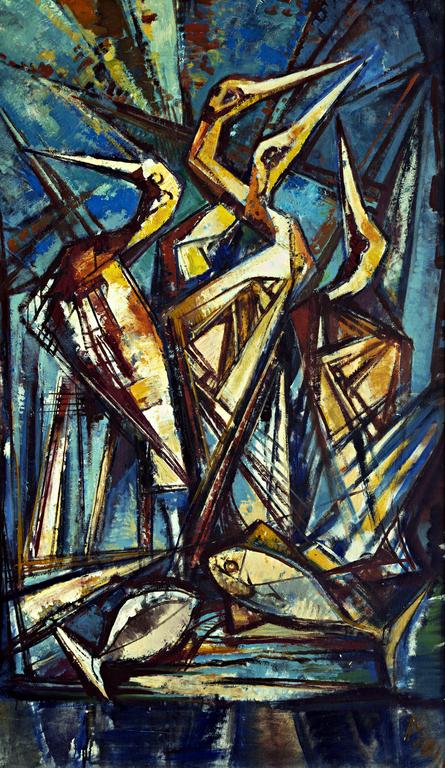Walter Bernstein: Kraniche, 1963 (Cranes)

Acrylic, 62 x 140 cm
Berthold Brecht: Die Liebenden
Seht jene Kraniche in großem Bogen!
Die Wolken, welche ihnen beigegeben
Zogen mit ihnen schon als sie entflogen
Aus einem Leben in ein anderes Leben.
(…)
So mag der Wind sie in das Nichts entführen.
Wenn sie nur nicht vergehen und sich bleiben
So lange kann sie beide nichts berühren
So lange kann man sie von jedem Ort vertreiben
Wo Regen drohen oder Schüsse schallen.
So unter Sonn und Monds verschiedenen Scheiben
Fliegen sie hin, einander ganz verfallen.
Four cranes dominate this picture, their heads raised high, two fish at their feet, in muted dark brown and blue. They stand close together; they seek and give each other protection in their community. These extraordinary birds have inspired people to countless representations, myths and stories from ancient Egypt or China to contemporary times. It is no coincidence that Walter Bernstein also painted a whole series of crane pictures. From 1936 to 1939 he was married to the dancer Bertha née Bodmer (stage name Albertine Comberto) in his first marriage, which ended abruptly with Bertha's death. Bernstein processed this decisive event with his crane pictures. The poem "The Lovers" (1927) by Berthold Brecht played a special role for Bernstein, because Brecht used the image of flying cranes as a symbol of love.
Walter Bernstein (*1901 in Neunkirchen, †1981 ibid., both in Germany) is omnipresent in many churches and schools in Saarland: From 1962 on, he received numerous commissions for art in public spaces throughout Saarland and depicted the lives of so-called ordinary people. They could identify with his works: the working world of the miner, which was characterized by mining and industry. Bernstein, a founding member of the Saarland Secession and a member of the Neunkirchen circle of artists, is described as "'the master of the industrial picture" and "obsessive painter" who "painted everything he could get his hands on". Other main themes of the devout artist were religious motifs and depictions of human suffering. As early as 1963, Walter Bernstein was the fourth artist ever to show his works at the academy. In 2017, the academy, together with the Stiftung europäische Kultur und Bildung foundation and the Förderstiftung Walter Bernstein foundation, organised another Bernstein exhibition posthumously under the title "The Industrial Painter - His View of Industry and Man".